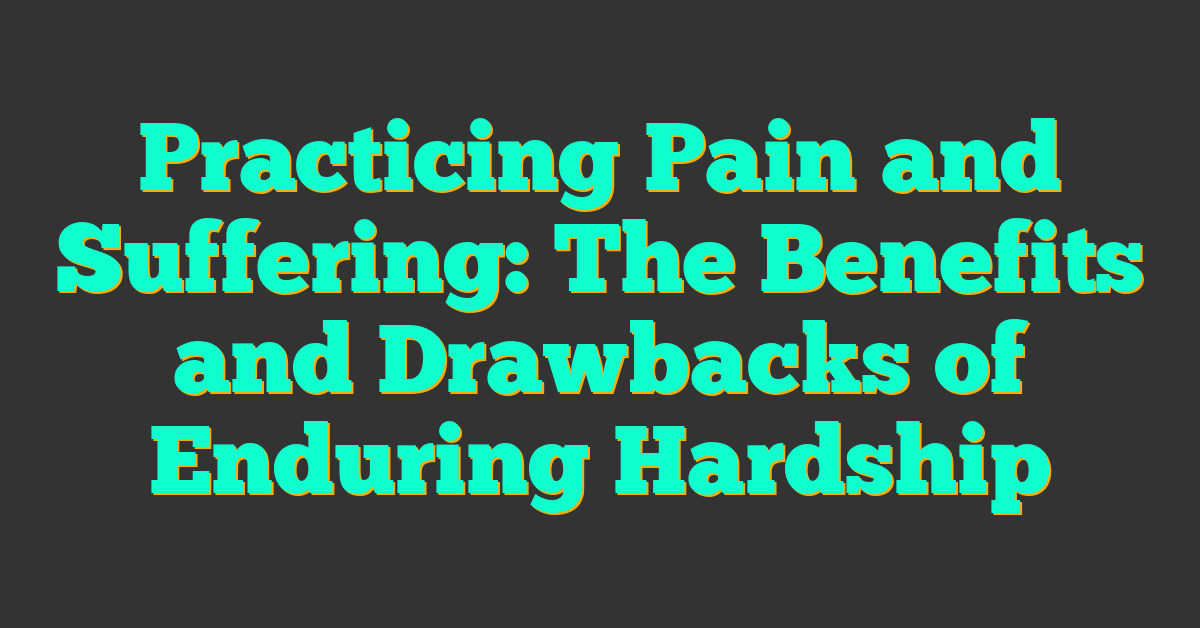If you’re reading this, chances are you’ve experienced some form of pain or suffering in your life. Maybe it was physical pain from an injury or illness, or emotional pain from a breakup or loss of a loved one. Whatever the cause, pain and suffering are an inevitable part of the human experience. But what if you could learn to practice experiencing pain and suffering in a different way? What if you could find ways to move beyond them and live a more fulfilling life?

Understanding Pain and Suffering
Before we can explore how to practice pain and suffering, it’s important to understand what they are. Pain is a physical sensation that can range from mild discomfort to intense agony. Suffering, on the other hand, is the emotional response to pain. It’s the feeling of distress, discomfort, or unhappiness that often accompanies physical or emotional pain. While pain and suffering are often intertwined, it’s possible to experience one without the other.
Psychological Approaches to Pain
Many psychological approaches have been developed to help people manage pain and suffering. These include cognitive-behavioral therapy, mindfulness-based stress reduction, and acceptance and commitment therapy, among others. These approaches aim to help individuals change the way they think about and respond to pain and suffering, ultimately helping them to live more fulfilling lives.
Key Takeaways
- Pain and suffering are an inevitable part of the human experience.
- Psychological approaches, such as cognitive-behavioral therapy and mindfulness-based stress reduction, can help individuals manage pain and suffering.
- Practicing self-care and reflection can also help individuals move beyond pain and suffering and live more fulfilling lives.
Understanding Pain and Suffering
https://www.youtube.com/watch?v=jkafKDdHvPA&embed=true

Pain and suffering are two concepts that are often used interchangeably, but they are not the same thing. Pain is a physical sensation that can be caused by an injury or illness. Suffering, on the other hand, is a psychological experience that can be caused by pain, but it can also be caused by other factors such as emotional distress or social isolation.
The Nature of Pain
Pain is a complex phenomenon that involves both physical and emotional components. When you experience pain, your brain receives signals from your nerves that something is wrong. These signals are processed in different areas of the brain, including the sensory cortex, which is responsible for the physical sensation of pain, and the limbic system, which is responsible for the emotional response to pain.
Emotional Versus Physical Pain
Emotional pain is often described as a feeling of sadness, grief, or heartache. It can be caused by a variety of factors, including the loss of a loved one, a breakup, or a traumatic event. Physical pain, on the other hand, is a sensation that is felt in the body. It can be caused by an injury, illness, or medical condition.
Chronic Pain and Its Impact
Chronic pain is pain that lasts for more than three months. It can be caused by a variety of factors, including an injury, illness, or medical condition. Chronic pain can have a significant impact on your mental health, as it can lead to feelings of frustration, hopelessness, and depression. It can also affect your ability to perform daily activities and can lead to social isolation.
In conclusion, pain and suffering are complex phenomena that involve both physical and emotional components. Understanding the nature of pain and the impact of chronic pain on mental health is essential for managing pain and suffering effectively.
Psychological Approaches to Pain
https://www.youtube.com/watch?v=FeLsHEpXAik&embed=true
Living with pain can be challenging and exhausting, but there are psychological approaches that can help you manage it. Here are a few strategies that you can try:
Mindfulness and Acceptance
Mindfulness is a technique that involves focusing your attention on the present moment and accepting your experience without judgment. It can help you become more aware of your thoughts and emotions, which can be helpful when you’re dealing with pain. By practicing mindfulness, you can learn to observe your pain without becoming overwhelmed by it.
Dialectical Behavior Therapy (DBT)
Dialectical Behavior Therapy (DBT) is a type of therapy that was developed by Marsha Linehan to help people with borderline personality disorder. However, it has also been found to be helpful for people with chronic pain. DBT focuses on teaching skills for managing emotions and coping with distress. It can also help you develop a more positive outlook on life.
Cognitive Strategies for Coping with Pain
Cognitive strategies involve changing the way you think about pain. For example, you might challenge negative thoughts that are making your pain worse. You might also try to focus on positive aspects of your life, such as your relationships or hobbies, to take your mind off the pain. Additionally, you might try to reframe your pain as a challenge that you can overcome.
By using these psychological approaches, you can learn to manage your pain and improve your quality of life. Remember that it’s important to work with a qualified mental health professional to develop a treatment plan that’s right for you.
The Role of Emotions in Suffering
https://www.youtube.com/watch?v=ZOyaeXg_pWQ&embed=true
When you experience pain, whether physical or emotional, it is natural to feel a range of negative emotions such as anxiety, anger, and bitterness. These emotions can be overwhelming and make it difficult to navigate through the suffering. However, it is important to realize that emotions are a natural response to pain and that they play a crucial role in the healing process.
Navigating Negative Emotions
It is important to acknowledge and accept negative emotions when experiencing pain and suffering. Suppressing or ignoring these emotions can lead to further distress and even physical symptoms. Instead, try to identify and express your emotions in a healthy way. This may include talking to a trusted friend or therapist, journaling, or engaging in creative activities.
The Pursuit of Happiness and Joy
While negative emotions are a natural response to pain, it is also important to actively pursue happiness and joy in your life. This may include engaging in activities that bring you pleasure, spending time with loved ones, or practicing gratitude. Focusing on positive emotions can help counterbalance the negative emotions associated with pain and suffering.
Radical Acceptance in Healing
Radical acceptance is the practice of fully accepting and embracing your current situation, no matter how difficult or painful it may be. This can be a powerful tool in the healing process, as it allows you to let go of resistance and move forward with a sense of peace and clarity. Radical acceptance can involve practicing forgiveness, letting go of expectations, and embracing the present moment.
In summary, emotions play a crucial role in the experience of pain and suffering. While negative emotions can be overwhelming, it is important to acknowledge and express them in a healthy way. Pursuing happiness and joy can also help counterbalance negative emotions. Finally, radical acceptance can be a powerful tool in the healing process, allowing you to let go of resistance and move forward with a sense of peace and clarity.
Moving Beyond Pain and Suffering
https://www.youtube.com/watch?v=GdKWyZ3_97I&embed=true
« Powerful Breathing Techniques for Cycling: Improve Your Endurance and Performance
Power Packed Pre Workout Meals: Fuel Up for Maximum Results »
Dealing with pain and suffering is never easy, but it is possible to move beyond it and find a new sense of freedom and purpose in life. To do so, you need to focus on building resilient relationships, adapting to life’s challenges, and finding freedom through letting go.
Building Resilient Relationships
One of the keys to moving beyond pain and suffering is to build resilient relationships with others. This means surrounding yourself with people who support and encourage you, even when times are tough. It also means being willing to reach out for help when you need it, and being there for others when they need you.
Adapting to Life’s Challenges
Life is full of challenges, and learning to adapt to them is essential for moving beyond pain and suffering. Whether you’re dealing with losing a job, suing someone, or simply facing the reality of a difficult situation, it’s important to stay focused on the positive and keep moving forward. This might mean learning new skills, seeking out new opportunities, or simply finding ways to stay positive and motivated.
Finding Freedom Through Letting Go
Finally, one of the most important things you can do to move beyond pain and suffering is to find freedom through letting go. This means letting go of the things you can’t control, and focusing on the things you can. It means accepting reality for what it is, and finding ways to make the most of it. It also means being willing to forgive yourself and others, and to move forward with a sense of purpose and hope.
By focusing on building resilient relationships, adapting to life’s challenges, and finding freedom through letting go, you can move beyond pain and suffering and find a new sense of purpose and fulfillment in life. So if you’re struggling with pain and suffering, don’t give up. Keep moving forward, and remember that there is always hope for a better tomorrow.
Practical Self-Care and Reflection
https://www.youtube.com/watch?v=kkt0otFeJZo&embed=true
When dealing with pain and suffering, it’s important to take care of yourself. This means developing a self-care routine that works for you, practicing reflection and mindfulness, and training your mind for resilience.
Developing a Self-Care Routine
Developing a self-care routine can help you cope with the challenges you face. This can include things like exercise, healthy eating, and getting enough sleep. It’s important to find what works for you and make it a regular part of your routine.
Some other self-care ideas include:
- Taking a relaxing bath
- Spending time in nature
- Listening to music
- Practicing yoga or meditation
Remember, self-care is not selfish. Taking care of yourself will help you be better prepared to deal with whatever comes your way.
The Importance of Reflection and Mindfulness Practices
Reflection and mindfulness practices can help you process your emotions and thoughts. This can include journaling, talking with a therapist, or simply taking a few moments to be still and quiet.
Mindfulness meditation is a great way to practice being present in the moment. This involves focusing on your breath and observing your thoughts without judgment. Over time, this practice can help you become more aware of your thoughts and emotions, and better able to manage them.
Training the Mind for Resilience
Training your mind for resilience means learning how to bounce back from difficult situations. This involves developing a growth mindset, practicing self-compassion, and cultivating a sense of gratitude.
A growth mindset means approaching challenges as opportunities for growth and learning. Instead of seeing failure as a reflection of your abilities, you see it as a chance to learn and improve.
Self-compassion means treating yourself with kindness and understanding, even when things don’t go as planned. This involves acknowledging your own pain and suffering, and offering yourself the same kindness and compassion you would offer to a friend.
Finally, cultivating a sense of gratitude means focusing on the positive things in your life, even when things are difficult. This can involve keeping a gratitude journal, or simply taking a few moments each day to reflect on the things you’re thankful for.
By developing a self-care routine, practicing reflection and mindfulness, and training your mind for resilience, you can better cope with pain and suffering, and find a sense of peace and well-being.
Frequently Asked Questions
https://www.youtube.com/watch?v=Mnh1wymHxOo&embed=true
What are effective strategies to alleviate chronic pain and improve quality of life?
Chronic pain can be debilitating, affecting your ability to perform daily activities and enjoy life. However, there are various strategies you can use to alleviate chronic pain and improve your quality of life. These include:
Physical therapy: Physical therapy can help improve your flexibility, strength, and range of motion, which can reduce pain and improve your ability to perform daily activities.
Medications: Pain-relieving medications, such as nonsteroidal anti-inflammatory drugs (NSAIDs), opioids, and muscle relaxants, can help alleviate chronic pain.
Mind-body therapies: Mind-body therapies, such as meditation, yoga, and tai chi, can help reduce stress and anxiety, which can exacerbate chronic pain.
In what ways can nurses play a pivotal role in assessing and managing a patient’s pain?
Nurses play a crucial role in assessing and managing a patient’s pain. They are responsible for:
Assessing the patient’s pain: Nurses use various pain assessment tools to evaluate the patient’s pain intensity, location, and quality.
Administering pain-relieving medications: Nurses are responsible for administering pain-relieving medications and monitoring the patient’s response to the medication.
Educating patients: Nurses educate patients on pain management techniques, such as relaxation techniques and distraction techniques.
What are the ‘5 A’s’ of chronic pain management and how can they be applied?
The ‘5 A’s’ of chronic pain management are:
Analgesia: Providing pain relief through medications or other pain management techniques.
Activities of daily living: Helping patients perform daily activities, such as bathing, dressing, and eating.
Adverse effects: Monitoring and managing any adverse effects of pain medications.
Affect: Addressing the emotional impact of chronic pain on the patient.
Assessment: Continuously assessing the patient’s pain and adjusting the pain management plan accordingly.
These ‘5 A’s’ can be applied by healthcare providers to provide comprehensive pain management to patients with chronic pain.
What coping mechanisms are crucial for individuals dealing with chronic pain?
Individuals dealing with chronic pain can benefit from various coping mechanisms, such as:
Relaxation techniques: Relaxation techniques, such as deep breathing and progressive muscle relaxation, can help reduce stress and alleviate pain.
Distraction techniques: Engaging in enjoyable activities, such as reading, listening to music, or watching a movie, can help distract from the pain.
Social support: Seeking support from family, friends, or support groups can help reduce feelings of isolation and improve mood.
How does Buddhism differentiate between physical pain and emotional suffering?
In Buddhism, physical pain is seen as a natural part of life, while emotional suffering is seen as a result of our attachment to things that are impermanent. Buddhism teaches that by letting go of our attachment to things, we can reduce our emotional suffering and find peace.
What ethical considerations should be taken into account when managing pain to minimize suffering?
When managing pain, healthcare providers should consider the following ethical considerations:
Respect for autonomy: Patients have the right to make decisions about their own pain management.
Beneficence: Healthcare providers should act in the best interests of the patient and provide effective pain management.
Non-maleficence: Healthcare providers should avoid causing harm to the patient through pain management.
Justice: Pain management should be provided equitably, without discrimination or bias.










